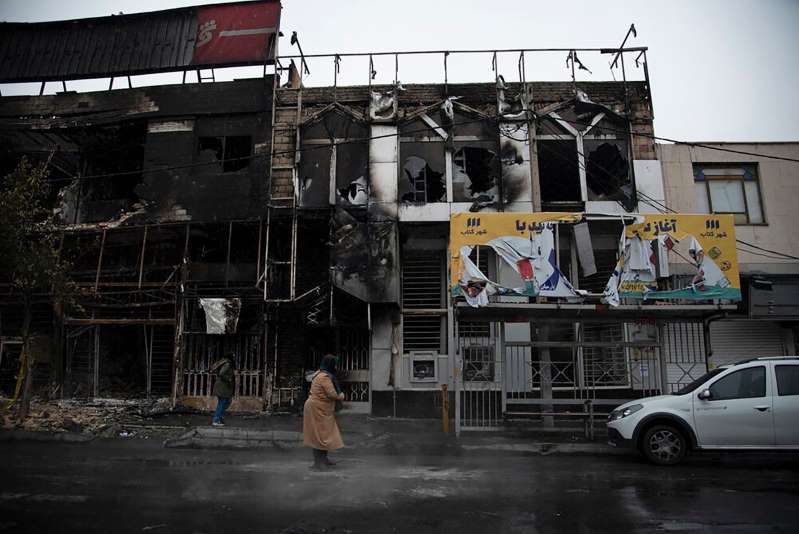By Benoit Faucon, Aresu Eqbali, Wall Street Journal–
Tehran has moved to quell violent unrest sparked by a fuel-price increase by handing out cash stipends to the poor and orchestrating pro-government demonstrations to marshal support for a policy intended to boost the sanctions-hit economy.
The new measures, which the government said had taken effect on Tuesday, come amid reports of a rising death toll and more arrests of protesters in Tehran and other major cities, where demonstrators burned and destroyed banks, gas stations and security bases.
The moves show how Tehran is struggling to address the public’s deep discontent while balancing its books. The government is struggling to prop up living standards as its oil-dependent economy comes under pressure from U.S. sanctions.
In a bid to cushion the blow from the fuel increase, the government boosted monthly cash subsidies to 60 million low and middle-income people, by at least $13 per head, the official Islamic Republic News Agency reported on Tuesday. The measure had been decided before the fuel increase, but was implemented after the protests.
But people are losing patience, and some see fuel-price increase as a pretext for triggering the latest bout of antigovernment protests.
“People are angry,” said a former Iranian oil official who has been involved in formulating current government policy on fuel supplies. “In two days, it could be something else,” he said.
Fearing the fuel-price increase will spur inflation, the government has mobilized inspectors to catch unregulated price increases on food and other commodities.
Iran’s top paramilitary force, the Islamic Revolutionary Guard Corps, has said public and private infrastructure—including banks, gas stations and security bases—were burned and destroyed since protests broke out over the weekend. The IRGC on Monday threatened to crack down on protesters.
At least 106 protesters in 21 cities have been killed in the demonstrations, human-rights group Amnesty International said on Tuesday. The government hasn’t given a tally.
A spokesman for Iran’s representation at the United Nations in New York said “any casualty figures not confirmed by the government are speculative and not reliable.” He said Iranians are allowed to “freely exercise their right to protest in a peaceful environment.”
But the unrest has been marked by a degree of violence not seen in previous protests.
Pro-government news outlets report security personnel also have been killed in the unrest. The conservative Fars news agency reported that armed protesters had killed one police captain in Khuzestan, an Arab-dominated area of western Iran. Rioters stabbed three members of Iran’s Basij paramilitary security force to the west of the capital, the IRGC alleged.
“Both friends and enemies know we have pushed back the enemy in military, political and security war,” Supreme Leader Ali Khamenei said late Tuesday, adding, “We will decisively push back the enemy in the economic war, too.”
On Tuesday, Capt. Hussein Rahimi, the head of the capital’s police, said a large number of protesters in Tehran were being detained, and that the police would make more arrests, Iranian news agencies reported. Gholam-Hossein Esmaeili, a spokesman for the Iranian Judiciary, alleged some of those detained were members of groups based abroad that seek to topple the regime.
Over the past decade, Tehran has repeatedly responded to antigovernment demonstrations. Iranians have marched regularly since the contested re-election of then-President Mahmoud Ahmadinejad in 2009, and later to express grievances over economic hardships, prompting the government to try to balance police repression with measures to cushion the pain.
“The confidence with which the government responded to the unrest shows it has honed protest-management techniques,” said Sanam Vakil, an Iran-focused research fellow at London’s Royal Institute of International Affairs, referring to massive deployment of security personnel and the temporary shutdown of internet connections.
Protests appeared to recede on Tuesday. But Ms Vakil warned that unrest could return, as the government is “not addressing interconnected grievances that are widespread.”
The protests in Iran are part of a wave of popular anger that has buffeted the region, from North Africa to Lebanon and Iraq. Iran is deeply invested in the latter two countries, and economic woes there have triggered an upsurge in anti-Iranian sentiment.
In Iran, authorities have confronted the unrest with pro-government counter-demonstrations. Official news agencies have shown crowds of pro-government marchers in Tabriz and other northwestern cities backing the government and its fuel-subsidy cut.
Iran’s shipments of crude—historically the country’s largest revenue source—have collapsed because of U.S. sanctions, forcing the government to seek other revenue.
Tehran has defended the fuel-subsidy cut. Officials say it will undermine smugglers who take advantage of cheap products sold in Iran to resell them in neighboring countries where they are comparably more expensive. The price increase will also increase the amount of fuel available for legitimate exports, said Ali Rabiei, a government spokesman.
But doing away with the fuel subsidy has led to a 50% increase in the price of gasoline and necessitated rationing, according to Eurasia Group, a political-risk research consulting firm. The gas-price increase and rationing will trigger limited protests in the near term, Eurasia analyst Henry Rome wrote in a research note. Yet it will also put the economy “on a more stable footing as it braces for another year under severe U.S. sanctions.”
Write to Benoit Faucon at benoit.faucon@wsj.com


Leave A Comment
You must be logged in to post a comment.